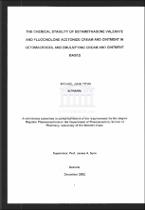The chemical stability of betamethasone valerate and fluocinolone acetonide cream and ointment in cetomacrogol and emulsifying cream and ointment bases
Abstract
The corticosteroids are powerful anti-inflammatory molecules but their usage is hampered by adverse effects. To minimise their adverse reactions, proprietary brands of topical corticosteroids are commonly diluted with a variety of bases. Dilution may affect the stability of the corticosteroid molecule and may result in accelerated degradation. This degradation may vary depending on the diluent base used. Such dilutions are also made in the Western Cape Department of Health public health system where unique formulations of cetomacrogol and emulsifying preparations are used as diluents. Because of the uncertainty of how these diluents would affect the steroid molecules, no accurate expiry dates could be allocated to the diluted preparations. This study set out to determine the chemical stability of betamethasone
valerate and fluocinolone acetonide creams and ointments when diluted with the bases used in the public hospital system and to assign shelf lives to them. Samples of the branded topical corticosteroid products used by the Western Cape Department of Health were diluted 1 :10 and 50:50 with cetomacrogol and emulsifying cream and ointment bases. The diluted preparations were stored protected from light, moisture and air at 25'C. Samples of the preparations were assayed at intervals for their corticosteroid content using reverse phase High Performance Liquid Chromatography. These concentrations of corticosteroid provided a degradation profile of each preparation from which degradation rate constants were determined and shelf lives calculated. The HPLC method used was sensitive, accurate and specific for the active ingredients studied. The retention times of betamethasone valerate and fluocinolone acetonide were 4,00 and 5,15 minutes respectively.
Betamethasone valerate was significantly more stable in the cream dilutions than in the ointment dilutions (e g. 1 .10 dilution in cetomacrogol cream t* = 5,46 +- months vs 1 :10 dilution in cetomacrogol ointment tgo = 1 ,62 +- months P = 0,0181 ). Conversely, fluocinolone acetonide was more stable in the ointment dilutions than in the cream dilutions but not significantly so (e.9. 1:10 dilution in cetomacrogol ointment tgo = 12,69 +- months vs 1 :10 dilution in cetomacrogol cream tro = l,$! +- months P = 0,1938). ln general, both corticosteroids degraded more slowly when diluted with cetomacrogol cream (e.9. 1 :10 dilutions of betamethasone valerate cream tro = 5,46 +- months and fluocinolone acetonide cream teo= 2,63 +- months) than with emulsifying cream (e.g. 1 :10 dilutions of betamethasone valerate cream tno = 3,05 +- months but not significantly so P = 0,8280 and fluocinolone acetonide cream tro= 0,0111 +- months extremely significantly so P<0,0001) and more slowly when diluted with cetomacrogol ointment (e g. 1 :10 dilutions of betamethasone valerate ointment tso = 1 ,62 +- months and fluocinolone acetonide ointment tso = 12,69 +- months) than with emulsifying ointment (e.g. 1 :10 dilutions of betamethasone valerate ointment t* = 0,18 +- months and fluocinolone acetonide ointment 1 .10 t* = 9,81 +- months although not significantly so P = 0,6590). Also, generally, the more concentrated dilutions were more stable than the more dilute ones (e.g 50:50 dilution of betamethasone valerate in cetomacrogol ointment tro = 4,33 +- months vs 1:10 dilution tgo = 1,62 months significantly so P = 0,0140 and 50:50 dilution of fluocinolone acetonide in cetomacrogol ointment t* = 46,90 +- months vs 1:10 dilution tro = 12,69 +- months although not significantly so P = 0,6005). Due to the rapid breakdown of the molecules it is therefore recommended that 1 :10 dilutions of betamethasone valerate ointment not be made using emulsifying ointment nor should branded products of fluocinolone acetonide be diluted with emulsifying cream at all. The calculated shelf lives should be used as a guide when the various combinations of steroids and diluents are to be used.

